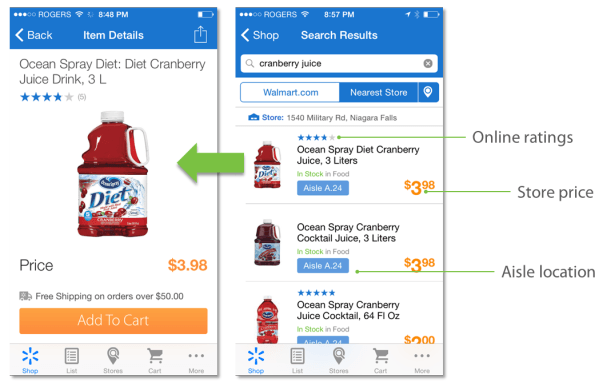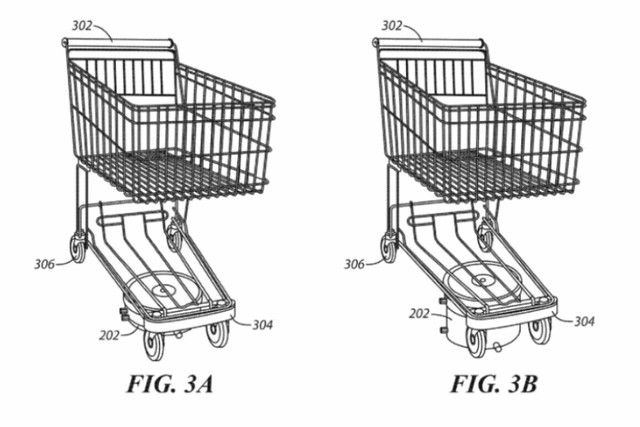Bricks and Clicks: How Walmart is Winning with Digital Technology

This post examines how Walmart is adapting its business model and operating model to maintain its leadership position in traditional retail while gaining a stronghold in eCommerce
When most people think of Walmart, they do not think of high technology. But the Bentonville behemoth has made major strides in the past ten years towards embracing digitization, and in 2015 topped the list of biggest technology spenders worldwide at $10.5B (6). Walmart has not only made eCommerce part of its business model, it has sought to thrive in this space through innovation and acquisitions. It has also enhanced the day-to-day operating model by investing in technologies that make the shopping experience more enjoyable. There is still room to improve, but overall Walmart has treated digitization as a major opportunity, using it to further the company tenet, “Save Money, Live Better”.
BUSINESS MODEL CHANGES
Initially, the advent of eCommerce came as a threat to Walmart, which operates over 11,500 brick-and-mortar stores internationally (1). Walmart proactively addressed this challenge by entering the eCommerce space with Walmart.com in 2000 (1). Since then, the company has invested billions in its online operation but has trailed Amazon on every success metric (2). In 2015, Amazon posted more than seven times Walmart’s $13.7B in online sales (4). Walmart’s August 2016 acquisition of Jet for $3.3B signifies a renewed commitment to optimizing the online shopping experience as well as the behind-the-scenes logistics (3). The two companies will operate semi-autonomously, Walmart will benefit from Jet’s proprietary technology in “gain sharing”, which encourages customers to buy more items at once to reduce supply chain and logistics costs. (3)
OPERATING MODEL CHANGES
One major operating model shift that Walmart is experimenting with is online grocery shopping with is same-day pickup. This move is an attempt to take advantage of something Amazon does not have: a network of thousands of physical stores. Since 2015, Walmart has expanded this program from five stores to 80 across the U.S. (4) Though it may seem odd to order online only to drive to the store, customers seem to ascribe value to having their groceries packed and carried to the car. This unique intersection of new technology and traditional retail could only be achieved by Walmart, which has a location within 10 miles of 90% of Americans’ homes (4).
Another addition to the Walmart operating model is @WalmartLabs, an innovative group within Walmart with a mission “to build products that seamlessly integrate the online and in-store shopping experiences for millions of customers” (5). Heavily weighted with data scientists and engineers rather than retail specialists, it functions as an “idea incubator” focused on innovations that will better connect shoppers with Walmart in the future. So far, this Silicon Valley -based group has made use of cutting edge technology in two ways:
- Introducing new, personalized features to Walmart’s website and mobile app – this includes a “Search My Store” feature (pictured below) that provides store-specific maps and product reviews
- Using Walmart’s wealth of customer data to better understand and predict purchasing behavior
While @WalmartLabs focuses primarily on apps and big data, there is a group within Walmart working on another version of smart, connected products: artificial intelligence. In September 2016, Walmart was granted a patent for self-driving shopping carts (pictured below):
The idea is that detachable motors will drive carts to customers when summoned (7). In the short term, this may be no more than a gimmick to draw shoppers to the brick-and-mortar store. Over time, however, Walmart plans to use this technology as part of a larger robotized inventory system whereby carts pick up and transport items across warehouses and stores (7). This could have positive implications for customer experience and cost management, but likely negative implications from a job loss standpoint.
WHAT’S NEXT?
Walmart has adapted to changing times by expanding into eCommerce and, at the same time, making some big bets on operating model changes meant to help people “Save Money, Live Better”. Walmart should continue investing in connected products and services, but I caution them not to lose sight of the needs of the core customer base. For instance, as helpful as the Walmart app may be, not all Walmart customers have smart phones. The store should investigate the possibility of installing in-store kiosks or even loaning shoppers a device for the duration of the trip. Furthermore, nearly 85% of Walmart customers pay in cash or cash equivalent (8). Walmart has tried to cater to this contingent with a “Pay with Cash” program that allows customers to order online and then pay at their local store within 48 hours. This seems cumbersome and not in the spirit of a truly streamlined experience. One workaround could be encouraging customers to buy gift cards while in the store, so that next time they shop online they have the equivalent of cash at their fingertips. There’s one thing Walmart and technology certainly have in common: neither is going anywhere anytime soon.
Word count: 796
- “Our Story.” Walmart Corporate – We save People Money so They Can Live Better.Walmart, n.d. Web. 17 Nov. 2016
- Pettypiece, Shannon, and Selina Wang. “Wal-Mart to Acquire Jet.com for $3.3 Billion to Fight Amazon.” Bloomberg. N.p., n.d. Web
- “Walmart Agrees to Acquire Jet.com, One of the Fastest Growing E-Commerce Companies in the U.S.” Walmart Agrees to Acquire Jet.com, One of the Fastest Growing E-Commerce Companies in the U.S.p., 8 Aug. 2016. Web. 17 Nov. 2016.
- Halzack, Sarah. “How Walmart Plans to Transform the Way We Buy Groceries.” Washington Post. The Washington Post, 8 Oct. 2016. Web. 17 Nov. 2016.
- “Walmart: Where Digital Meets Physical.” Capgemini Consulting, 15 July 2015. Web. 15 Nov. 2016.
- Nash, Kim S. “Wal-Mart Spent $10.5 Billion on Information Technology in 2015.” WSJ. Wsj.com, 21 Apr. 2016. Web. 17 Nov. 2016.
- Brown, Bruce. “Self-driving Shopping Carts May One Day Make Their Way to a Walmart near You.” Digital Trends. Digital Trends, 14 Sept. 2016. Web. 17 Nov. 2016.
- Perez, Sarah. “Walmart Adds “Pay With Cash” For Online Shoppers At Walmart.com.” TechCrunch. 26 Apr. 2012. Web. 17 Nov. 2016.





Thanks, Jessica. Had no idea that Walmart was so thoughtful and adaptive around their implementation of technology.
I think it was a smart strategic move to create Walmart.com so long ago. Their innovation around same-day pick-up is also commendable. Taking that one step further though, I wonder why Walmart has not yet paired up with the likes of Uber, Instacart, etc. in order to deliver groceries directly to the homes of their customers. Seems like a decent opportunity to increase revenues by charging a commission per delivery.
You mention their ideas around in-store technology, such as self-operated shopping carts. I agree that this poses a serious risk from an employment standpoint. Presumably, Walmart would look to apply this in the longer term to the management of their warehousing and inventory. Given their nearly ubiquitous presence throughout the US, and the corresponding high levels of inventory and employment, Walmart would need to be careful about how such potential layoffs might impact brand perception on a broader scale.
Interesting article, Jess. I wonder if Walmart has thought about providing the technology to consumers directly in the store? I am in the group of people who wouldn’t want to purchase my fresh produce through an app / have someone else select my cuts of meat or the size of my broccoli. It would be neat to get to the store, have a iPad like device in the trolley/basket, and scan your own items (and potentially pay without having human interaction, but as you note, 85% pay in cash or cash equivalents so that may be less useful). The device could also provide recommendations for other items. For example, if you buy some Tostito chips, the device could recommend avocadoes and some refreshing Bud Light as complementary items, and provide the pricing and location (and maybe discounts / coupons) of those products. This would benefit the customer experience and make some money for Walmart – they could generate revenue from product placements like my Bud Light example above. The only issue here though, is that increased technology use could lead to job cuts, which you point out, would not go down well publicly.
I am shocked that 85% of Walmart customers pay with cash! They clearly are being very innovative with technology, particularly with ways to improve the in-store experience, but I think one thing that could help insulate them from competition from Amazon is to find a way to get these cash-paying customers to set up some sort of debit card with Walmart similar to what we saw with Alipay in the Alibaba case. I fear overtime Amazon Fresh will become more affordable (they have already lowered membership 40%) and with Amazon’s distribution centers, they eventually could reach delivery within an hour. However, if Walmart is able to establish a payment system for these cash customers they will become much stickier customers and rely on Walmart to be able to shop online.
Thanks for sharing! It is interesting how Walmart is currently integrating their in-store and online shopping experiences. I wonder how much online shopping has impacted the positioning of “every day low price” though. For example, customers with smartphones can easily look-up prices at competitors while shopping at Walmart, and determine where to purchase specific goods. At the same time this could simply be a short term concern, because in the long-run as their online base grows they could essentially turn their stores into warehouses with different delivery options as customers make their selections online.